Have you ever think of the weight of air around us?
Generally, we feel air doesn’t have any weight since it is not visible and just felt.
Are you wondering about, ‘Does air has mass?’!!
If you are interested, we can clear your curiosity about ‘air weight’ through this scientific experiment, i.e., ‘Balloon Balance Experiment.’ Here we go!
Balloon Balance Experiment
Hypothesis: We will prove that air has weight / mass by building a balance scale and performing an air weight experiment.
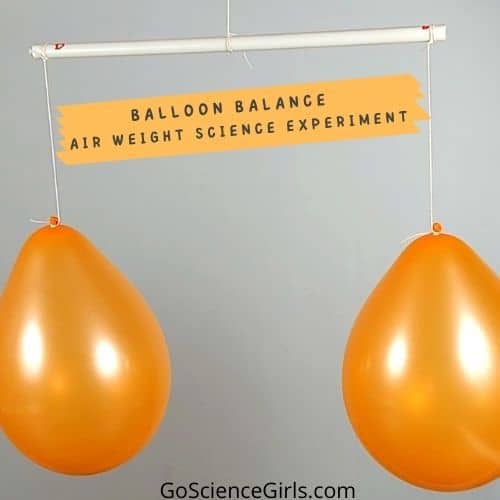
Materials Required
Check out the concise list of supplies…
- Two Balloons
- A piece of string
- Ruler / long stick (Wooden or steel)
- Any sharp object like needle or pin
- Scotch Tape
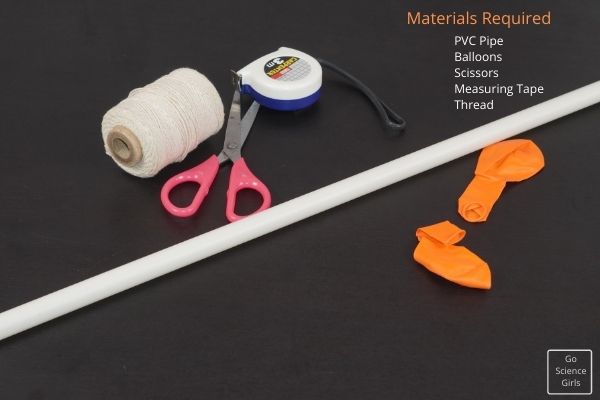
Building a Balloon Balance
Step-1: Build a balance using a ruler and strings! Take a ruler of your chosen material and give it a knot using a piece of string but precisely in the center. Make sure the string is strong enough to hold and balance the ruler scale in place.
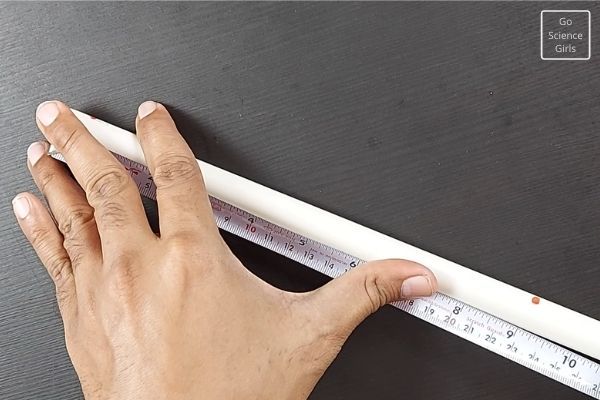
Step-2: Now, bring the balance over your work table and attach the other free end of the string to support on the top. If you have a readymade balance available readily at home, then you can also use it.
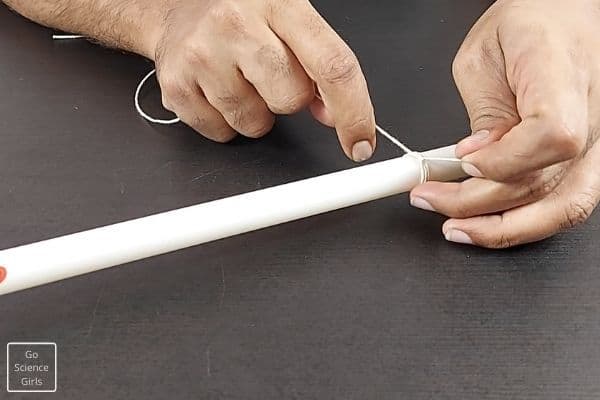
Step-3: Then, pick the two balloons and blow them up. But you need to blow the two balloons in equal size.
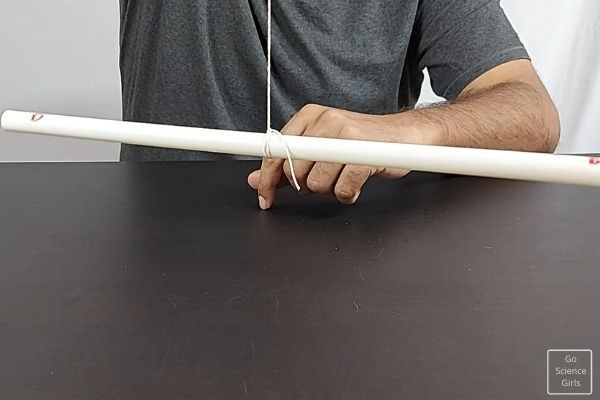
Step-4: After checking, give the balloons a knot at the mouth of them using an equal length piece of string.
Step-5: It is time to fix the balloons on either side ends of the ruler, leaving 3-4 inches of space from the end of the scale. Fix the balloons to the ruler using the other free end of the string attached to the balloon.
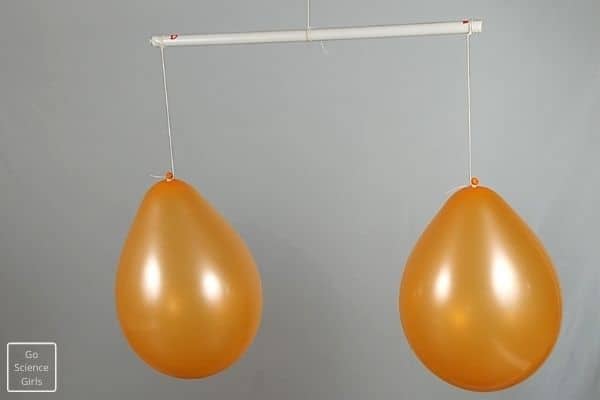
As we are taking equal length strings to both the balloons to secure them, we must mostly observe the balloons at the same height even after tying them to the ruler. Finally, you need to check whether the balloons are at equal height from the ruler.
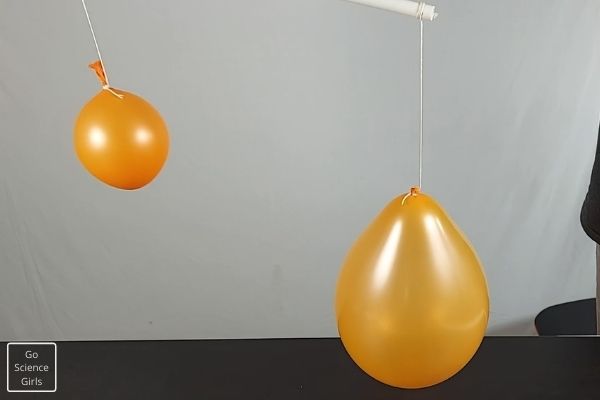
Step-6: At this stage, leave the balance attached with equal-sized and inflated balloons freely. That means let the balance adjust itself, and then you check, both the balloons remain at the same height as the ruler.
It shows that air inside both the balloons has equal mass and remains at the same height when left on balance freely.
Step-7: In step-7, we are going to prove that air has mass! To prove this, pick any sharp object and poke any of the two balloons.
Immediately, you can observe the balance goes down on the side where there is an inflated balloon and the side consisting of deflated balloon goes up.
Just like a see-saw, you can observe the actions of balance when you deflate one of the balloons using a sharp object.
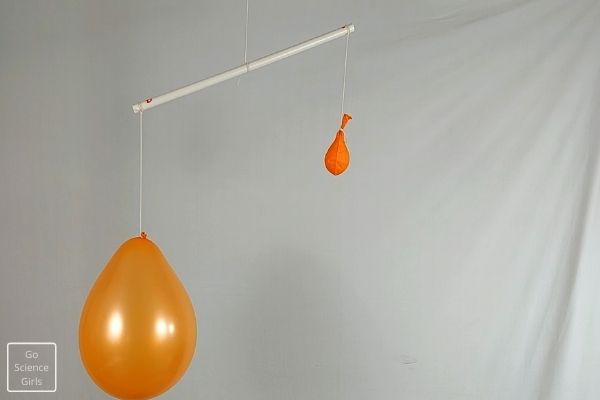
You can alter the experiment with varying mass of balloons to check the results.

Balloon Balance Experiment – Scientific Explanation
According to scientists, air is a type of matter that has mass and occupies space.
Does Air Have Weight?
Let us prove with our experiment that air has mass and takes up space. In the balloon balance experiment, we are blowing up balloons. When blow-up balloons, the air is entering inside them and making the balloons expand. So, this shows that the air occupies space which eventually proves that it has weight.
And when we tie the balloons to the scale with measurements and deflate one of them, the balance tilts i.e., the side attached to the inflated balloon will be on the lower side, and the side with deflated one goes upwards.
The deflated balloon loses its weight. And because of weight, the inflated balloon goes down, and the deflated one goes up on the scale. Using this, we can prove that air takes up space and has mass.
Air weights due to what?
When we blow up the balloon, the air inside the balloon is under high pressure. Because the amount of air inside the balloon is compressed within a certain amount of space available inside the balloon.
So when we blast it using a sharp object, the balloon’s skin moves away from the blast’s point, allowing the air to come outside. The compressed air comes out of the balloon when it blasts because it weighs more than the surrounding air weight. This shows that air has weight.
How much does a deflated balloon weigh?
A deflated balloon exhibits the weight of the (deflated) balloon and not the air.
Air has no weight when it is free to move from one place to another, but it contains weight when it is filled inside any container because the air inside a container compresses by the walls of balloons, which gives weight to the air inside the balloon.
Extension Ideas to the Balloon Balance Experiment
1) Try out many inflated balloons tied to the ruler scale on either side and perform the same experiment. Check whether there are the same final results or not!
2) Replace the deflated balloon with another inflated balloon and check what exactly happens.
3) Take many inflated balloons and tie them to the string side by side on either side of the scale. And check the results by blasting the balloons on one side at a time and one by one.
4) Try different-sized balloons and check what happens after the experiment.
Who discovered air has weight?
Galileo, a great scientist who discovered that ‘Air has Mass,’ but he could not prove his statements through scientific reasons adequately. And hence his remarkable discovery on-air weight became colder surrounding with a lot of controversies.
Later, Torricelli put his efforts on the same concept and surmised that air is less dense and exhibits less pressure on the hilly areas. But he just only explained the theory instead of proving it scientifically.
And finally, the scientist Blaise Pascal proved that air weights with proper explanations.
Does compressed air weigh anything?
As we already learned that compressed air exhibits weight more than the surrounding air moving freely outside through Balloon Balance Air has Weight Experiment. Let us see how much weight it reveals.
Compressed air weighs more than atmospheric air, and hence a certain amount of compressed air weighs more than the same amount of regular air. I.e., The weight of one cubic foot of air is 0.0807 pounds at 14.7 psi. If we compress the compressed air to 1000 psi, then the air weight per cubic foot is beyond 5 pounds. In this way, compressed air weight is calculated based on the pressure it is experiencing.
Check out other air pressure experiments:
FAQ’S
A: We can prove that air has mass by performing a simple science experiment, i.e., the ‘Balloon Balance Science Experiment’. Take a simple balance machine and tie equal-sized inflate balloons on either side of its lever. You will observe both the balloons hang at the same height from the ground. Now, blast any one of the inflated balloons and observe that the lever on the deflated balloon side tilts and moves upwards. While the inflated balloon still goes down because it has air which reveals mass. In this way, we can prove that air has weight.
A: When a balloon is filled with air, it expands because air has mass and occupies space. But a deflated balloon displaces its air into the surrounding air because it is compressed air with more weight than the regular air outside. So, it immediately displaces air outside when blasted and occupies no space. A deflated balloon doesn’t even hold any weight as there is no mass inside it.
A: One can find a balloon’s mass in two ways: One is an empty balloon weight without air, and the other is balloon mass with air. You need to pick a balloon for the first category and place it on the simple balance. You will see some reading changes on the lever. According to the readings, you can decide on an empty balloon’s weight that does not have air in it. And for the second category, you need to use ideal gas laws to find out the balloon’s mass that has air in it. I.e. PV= nRT
A: Yes, all types of gases consist of a certain amount of mass depending upon its amount present in a particular substance or container. Gases are invisible to the human eye, but we feel them through our skin because of the pressure they exhibit. But the gas particles stay intact by having large space in between them, unlike solids and liquids.
A: Matter is anything that takes up space and has weight. We can prove air is a matter using a balloon. So, pick a balloon and note down its weight using a simple balance before we fill in air into it. Now, blow the balloon using your mouth or a blower machine. Now the empty balloon expands and becomes large with a certain shape. It shows that it has air inside, occupying space, and expands the balloon to a certain size. Then, weigh the inflated balloon. You will see the inflated balloon weighs more than the empty one. From these two observations, we get to know that air takes up space and has weight. So, anything which has weight and occupies space is a matter, and hence the air is a matter.
A: Yes! Air takes up space because it is made of loosely packed air particles that have volume as well. Since it is a matter, it occupies space in the atmosphere. That is the reason living things can breathe in and out.
A: Sunlight is a combination of various rays, i.e., ultraviolet rays, visible rays, and infrared rays. And these rays emit radiation encompassed photon particles, which are tiny in size and move in space with high speed. As these particles do not have any weight or mass, they are not able to occupy space. When there is no scope for mass and taking up space by any object, then the object is not a matter. Since the sunlight is not made of matter, it does not fall under any state of matter.
A: Yes, water vapor occupies space during the process of turning the liquids into vapors. When liquids turn into vapor, there happens the expansion of liquid substance. It is due to the breakage of bonds that keep water molecules intact and results in steam formation. Such steam vapors act as gases and occupy more space than regular ones.
A: Light is nothing but an electromagnetic ray with a certain wavelength. It does take up space like protons and electrons.
A: Basically, the matter is of three different states, i.e., solid-state, liquid state, and gaseous state. All these three types of matter are different in their characteristic properties. And the particles that make these three matters are different and arrange themselves differently. If something refers to a matter, then it must exist in either of these three states. In our everyday life, the state of matter plays a significant role and has a very distinct form.

Great explanation! Even better than the 3rd grade science teacher.